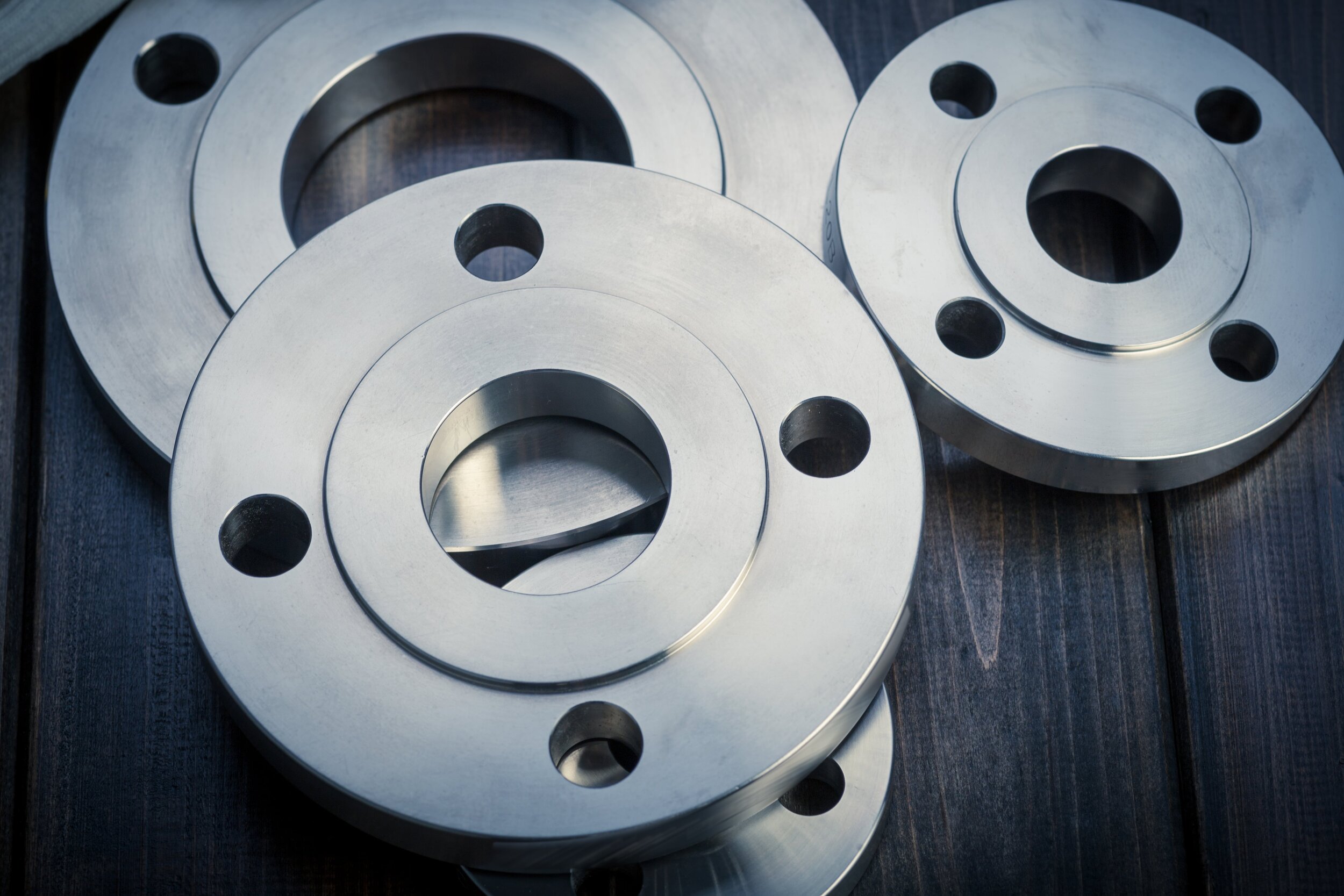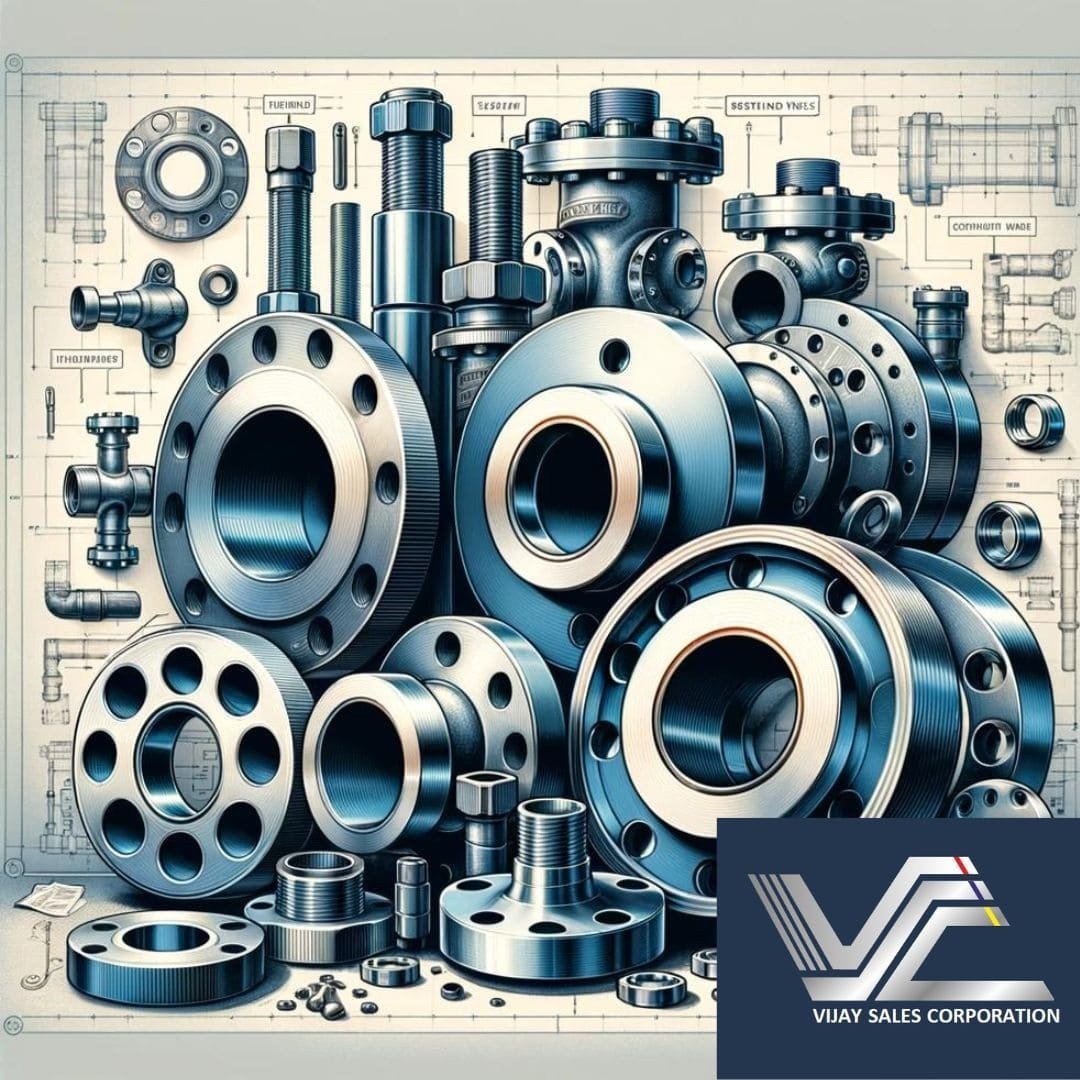MS Flanges – Premium Quality Flanges for Industrial Applications
Flanges
We at Vijay Sales Corporation have a large inventory of various types of Slip-on Flanges as per the various tables & specifications. We assure to provide our partners with the nest quality of Flanges in the market along with the most competitive price. The range of Flanges which we offer are ASA 150#, ASA 300#, Table D, Table E, Table F, Table H, ‘IS’ standard flanges, ND-16, ND-40 & ‘IBR’ quality flanges.
We have also introduced “VS” branded flanges which are as per BS16.5 standard- Class 150#. We have both slip-on and blind flanges in our range. We also provide Material Test Certificates for “VS” branded flanges.


Demystifying Flanges: The Essential Guide to Pipe Connections (and More!)
Introduction
Flanges are an integral part of countless industrial and residential applications, playing a crucial role in connecting pipes, valves, and other components. From towering skyscrapers to intricate plumbing systems, these versatile components ensure the reliable and efficient transfer of fluids, gases, and other materials. Whether you're a seasoned professional or a curious homeowner, understanding the world of flanges is essential for a wide range of projects and applications.
In this comprehensive guide, we'll demystify the realm of flanges, exploring their functions, types, benefits, and applications. We'll also delve into the intricacies of choosing the right flange for your specific needs, ensuring that your pipe connections are robust, leak-proof, and built to last. So lets dive into the fascinating world of flanges at Vijay Sales Corporation, where reliability meets innovation.
What are Flanges?
At their core, flanges are flared discs designed to facilitate secure connections between pipes, valves, and other components. They serve multiple critical functions, including providing structural strength, enabling attachment points, and ensuring a leak-proof seal between joined components.
Flanges come in various shapes, sizes, and materials, each tailored to meet the demands of different industries and applications. Their versatility is one of their greatest strengths, making them indispensable in a wide range of settings, from residential plumbing to heavy industrial environments.
Types of Flanges
The world of flanges is vast and diverse, with numerous types designed to cater to specific requirements. Here are some of the most common varieties:
Threaded Flanges: These flanges feature threaded connections, allowing for easy assembly and disassembly. They are commonly used in low-pressure applications and are available in various materials, including steel and plastic.
Slip-on Flanges: As the name suggests, these flanges slip onto the pipe and are secured with a weld or other fastening method. They are often used in high-pressure and high-temperature applications, offering excellent strength and durability.
Welding Neck Flanges: These flanges feature a protruding neck that is welded directly to the pipe, creating a strong and reliable connection. They are widely used in harsh industrial environments and can withstand extreme pressures and temperatures.
Socket Weld Flanges: Similar to welding neck flanges, socket weld flanges are designed to be welded to the pipe. However, they feature a recessed area instead of a protruding neck, making them more compact and suitable for applications with space constraints.
Blind Flanges: These flanges are used to seal off pipe ends or provide access points for maintenance and inspection. They are often employed in storage tanks, pressure vessels, and other enclosed systems.
| Flange Type | Description | Common Applications |
|---|---|---|
| Threaded | Flanges with threaded connections for easy assembly/disassembly | Low-pressure residential and commercial plumbing |
| Slip-on | Flanges that slip onto pipes and are welded or fastened | High-pressure and high-temperature industrial settings |
| Welding Neck | Flanges with a protruding neck welded directly to pipes | Harsh industrial environments, extreme conditions |
| Socket Weld | Flanges with a recessed area welded to pipes | Space-constrained applications, piping systems |
| Blind | Flanges used to seal off pipe ends or provide access points | Storage tanks, pressure vessels, enclosed systems |
Identify Your Flange Instantly – Free Online Tool by Vijay Sales Corporation
Benefits of Using Flanges
Flanges offer numerous advantages that make them an invaluable component in a wide range of applications. Here are some of the key benefits of using flanges:
Easy Assembly and Disassembly: Many flange types, such as threaded and slip-on varieties, allow for quick and easy assembly and disassembly, facilitating efficient maintenance and repairs.
Leak-Proof Connections: When paired with gaskets or other sealing materials, flanges create leak-proof connections, preventing costly and potentially hazardous leaks in piping systems.
Versatility: Flanges are available in a wide range of sizes, materials, and pressure ratings, making them suitable for various applications, from residential plumbing to high-pressure industrial settings.
Strength and Durability: Properly designed and installed flanges offer exceptional strength and durability, ensuring the long-term reliability of your piping systems.
Applications of Flanges
Flanges are versatile components that find applications in numerous industries and settings. Here are just a few examples:
Construction and Plumbing: Flanges are essential components in residential and commercial plumbing systems, connecting pipes, valves, and other fixtures.
Chemical and Petrochemical Industries: In these demanding environments, flanges play a crucial role in connecting pipes carrying hazardous materials, ensuring safe and efficient operations.
Oil and Gas: Flanges are indispensable in the oil and gas industry, facilitating the transportation of crude oil, natural gas, and other hydrocarbons through extensive piping networks.
Power Generation: From nuclear power plants to renewable energy facilities, flanges are used to connect piping systems carrying steam, coolants, and other fluids essential for power generation.
Wastewater Treatment: Flanges are employed in wastewater treatment plants, connecting pipes that carry sewage and other waste materials for treatment and disposal.
Choosing the Right Flange
With such a diverse range of flange types and applications, selecting the appropriate flange for your project is crucial. Here are some key factors to consider:
Pressure Rating: Flanges are designed to withstand specific pressure levels. It's essential to choose a flange with a pressure rating that meets or exceeds the requirements of your application to ensure safe and reliable operation.
Temperature Range: Different flange materials have varying temperature tolerances. Consider the operating temperatures of your system and select flanges capable of withstanding the expected temperature range.
Fluid Type: The type of fluid or material being transported through the piping system can impact flange selection. Some fluids may require specialized materials or coatings to prevent corrosion or degradation.
Size and Compatibility: Ensure that the flange size and dimensions are compatible with the pipes and components it will be connected to, preventing leaks and ensuring proper fit and alignment.
Material Selection: Flanges are available in various materials, including carbon steel, stainless steel, and even plastic. Consider factors such as corrosion resistance, strength, and cost when selecting the appropriate material for your application.
Conclusion
Flanges might be underappreciated, but their role in piping systems is undeniable. Offering a blend of strength, versatility, and reliability, they are fundamental to any project that involves piping. Make informed decisions by understanding the nuances of flange types and their applications.
For expert advice on flange selection or to explore our extensive range, reach out to Vijay Sales Corporation. We're here to ensure your piping systems are not just constructed
Understanding Flange Charts
A flange chart is a reference tool that provides information about the dimensions and specifications of various types of flanges. Flanges are used in piping systems to connect pipes, valves, and other equipment, and are available in a range of sizes, materials, and design standards.
A typical flange chart may include the following information:
Flange size: The size of the flange, usually expressed in inches or millimeters.
Bolt circle diameter: The diameter of the circle formed by the bolts that hold the flange together.
Number of bolts: The number of bolts required to secure the flange.
Bolt size: The size of the bolts used to secure the flange.
Flange thickness: The thickness of the flange.
Flange type: The type of flange, such as a weld neck flange, slip-on flange, or threaded flange.
Material: The material the flange is made of, such as carbon steel, stainless steel, or alloy steel.
Pressure rating: The maximum pressure the flange is designed to withstand, usually expressed in pounds per square inch (psi).
Standards: The design standards the flange is manufactured to, such as ANSI (American National Standards Institute), DIN (Deutsches Institut für Normung), or JIS (Japanese Industrial Standards).
Flange charts are often used by engineers, contractors, and other professionals to select the appropriate flange for a given application. They can be found in technical manuals, online resources, or from manufacturers or distributors of flanges.
Why Choose Vijay Sales Corporation for MS Flanges?
At Vijay Sales Corporation, we have a large inventory of MS Flanges ready for immediate delivery. We are committed to providing our partners with the best quality flanges available anywhere in India. We also assist our partners in matching the flanges with the valves they use and provide Hot Dip Galvanized flanges.

Bonus Section
Glossary of Flange Terms
Gasket: A sealing material, typically made of rubber or other compressible materials, used between flanges to create a leak-proof connection.
Bolting: The hardware (bolts, nuts, and washers) used to secure flanges together.
Pressure Rating: The maximum pressure a flange can safely withstand without failure or leakage.
Temperature Rating: The maximum and minimum temperatures a flange material can withstand without degradation or failure.
Flange Face: The surface of the flange that makes contact with the gasket or sealing material.
Flange Bore: The inside diameter of the flange, which must match the pipe size.
Frequently Asked Questions (FAQs) on Flanges
What is the purpose of a flange? Flanges are used to connect pipes, valves, and other components in piping systems, providing a secure and leak-proof connection.
How do I select the right flange for my application? Consider factors such as pressure rating, temperature range, fluid type, size compatibility, and material requirements when choosing a flange.
Can flanges be reused after disassembly? In some cases, flanges can be reused after disassembly, provided they are inspected for damage and the gasket or sealing material is replaced.
What is the difference between a slip-on flange and a welding neck flange? Slip-on flanges are slipped onto the pipe and secured with a weld or other fastening method, while welding neck flanges feature a protruding neck that is welded directly to the pipe.
How often should flanges be inspected and maintained? The inspection and maintenance frequency for flanges depends on the application, operating conditions, and manufacturer recommendations. Regular inspections can help identify potential issues and prevent failures.


